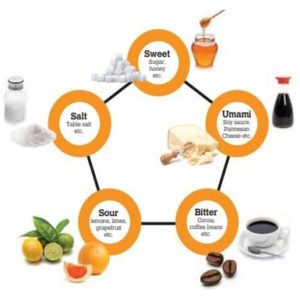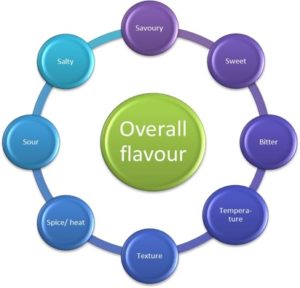Managing taste changes
Loss of taste may be a symptom of a COVID-19 infection. If you are concerned this may be affecting you please follow the latest government guidelines at www.gov.uk
There are many other conditions that can affect your taste. This information offers ideas and support to help manage taste changes.
This information is split into 4 sections.
Section 1: What is taste?
Section 2: Why do taste changes happen?
Section 3: What can you do to help?
Section 4: Medicine and supplements
Section 1 – What is taste?
There are 5 basic tastes;
sweet, sour, salt, bitter and savoury.

As food is chewed, it mixes with saliva.
This mixture then comes in contact with the taste buds.
Taste buds are mainly found on the tongue (between 2,000 – 5,000 taste buds). There are also taste buds on the inside of the cheek, the roof and back of the mouth. The smell of food also influences taste.
Messages from the taste buds and nose about smell are sent to the brain about taste and overall flavour.
Section 2 – Why do taste changes happen?
There are many reasons why your sense of taste may change. It may be due to treatments, medication the medical condition itself or a combination of these factors. Changes in taste can also arise with cancer, dementia and conditions that create breathing problems such as COVID-19 and COPD.
These factors may lead to changes to the taste buds, a lack of saliva or dry mouth feel, mouth infections and mouth soreness, which then change how taste messages are sent to your brain. This can then lead to the following:
- reduced taste sensitivity
- lack of taste
- changes to normal taste
- increased sensitivity to particular tastes
- temperature sensitivity
- reduced or increased smell sensitivity
People often describe taste changes in the following ways – ‘all food tastes the same’, ‘food is like cardboard’, ‘food has a metallic taste’, ‘I no longer like the taste of my favourite food’.
- Up to 76% of patients having treatment for cancer report taste changes and up to 45% report changes in smell. Taste changes may last for hours, days, weeks, or even many months but generally are temporary.
- If you have had certain types of surgery or radiotherapy for treatment of cancer, particularly to parts of your mouth, you may have more long-term, permanent changes to taste.
- It is currently thought that between 50 – 70% of COVID-19 positive patients may experience changes to taste and smell. Reports show that taste usually returns after about a month.
If you are avoiding a lot of foods and are struggling to maintain a healthy weight,
- ask a healthcare professional for additional information
- you may be referred to a Dietitian or if you have had cancer you could be referred to a Macmillan Specialist Dietitian.
Section 3 – What can you do to help?
a) Caring for your mouth and tongue
Check your mouth and tongue regularly – ask your doctor, nurse or radiographer about mouthcare, especially if your mouth feels/ looks coated, or your saliva seems thicker than usual.
Aim to keep your mouth clean and fresh especially before and after eating.
Having a dry mouth or lack of saliva can have an effect on taste. To help with this:
- try taking sips of fluid through the day
- try a humidifier water spray (plastic bottle type) to spray water into your mouth
- try rinsing your mouth with still or sparkling water before eating
- try sugar-free chewing gum to promote saliva production – take care with strong flavours as they can also alter the taste of food
- discuss artificial saliva options with your Doctor, Nurse, Pharmacist or Dietitian, sprays, gels and pastilles are available, (BioXtra, Biotene Oralbalance, Boots expert range dry mouth spray are a few options).
Drink adequate fluids (aim to have 8-10 glasses or mugs per day)
- try peppermint, ginger, fruit or green teas, lemonade, fruit juice or ginger ale – these can also help to mask unpleasant tastes
- if tea and coffee taste too bitter try strong savoury flavours such as Bovril, Marmite or Miso
- try using a straw and position it at the back of your mouth to bypass the taste buds if drinks have unusual or unpleasant tastes
- if food tastes overly strong try drinking ginger or peppermint tea before eating.
For more information about mouth care and cancer, ask your healthcare professional for ‘Mouth Care for Patients Undergoing Cancer Treatment’ (CISS-136).
b) Choosing and preparing food
You may find that your taste changes over time, it may be a process of trial and error to find foods that are more acceptable to you:
- try to eat the foods that you can manage most easily
- if the food affected is one you only eat occasionally, avoid that particular food and try it again in a few weeks’ time
- if it is food that you eat often, you will need to find a suitable alternative. Ask your healthcare professional for the booklet ‘Eating well with a small appetite’ (CISS 25) which contains more information about different food groups and alternatives.
Choose a variety of foods and try experimenting with different foods and flavours.
c) Experimenting with food, taste and flavours
Try changing the following aspects of food:
Texture
- this is also known as mouthfeel and can range from silky to crunchy,
- try combining a variety of textures. Crunchy and soft foods give variety to the experience of eating – for example: a crunchy cracker with soft cream cheese.
Temperature
- try combining warm and cold foods to give variety to the experience of eating, for example: hot custard with cold apple pie,
- the smell of food can increase unpleasant tastes – if this happens try eating cold foods.
Flavour
- try experimenting with different tastes to change the flavour balance, there is more information on the next page,
- try adding herbs and spices, but be careful with hot spices (such as chilli) if you have a sore mouth. There is a table at the back of the leaflet with some ideas.

Changing flavour balance
There are 5 main types of taste that affect overall flavour: sweet, sour, bitter, salty and savoury (umami). Changing the balance of these tastes may help overall flavour. These ingredients could be added as part of a marinade, during cooking or at the table.
Sweet
- Sweet ingredients – sugar, golden syrup, honey, maple syrup, stevia, jam, molasses, balsamic vinegar, cider vinegar, tomato ketchup and BBQ sauce,
- if food tastes too sour, too bitter or too spicy, try balancing this by adding sweet ingredients (this can help with sweet and savoury foods).
Sour/ acidic
- Sour or acidic ingredients – lemon, lime, orange or pineapple juice, all types of vinegar (balsamic, cider, white wine, rice), tomato puree, tamarind, yoghurt, sour cream and pickled vegetables,
- if food tastes too spicy or too sweet, try balancing this by adding sour/ acidic ingredients,
- be careful if you have ulcers or a sore mouth as acidic foods can irritate this,
- if you have an unpleasant metallic taste, acidic ingredients can be added to mask this.
Bitter
- Bitter ingredients – bitterness is found in cocoa powder, citrus peel, olives, mustard, tea, coffee, grapefruit juice, tonic water and beer,
- if food tastes too sweet or too salty, try balancing this by adding bitter tastes,
- if food tastes overly bitter try yoghurt, eggs, cheese, fish or tofu and adding salt,
- if tea and coffee taste bitter, try drinks made with milk e.g. hot chocolate, malted milk drink, milkshakes, smoothies made with yoghurt or savoury drinks such as Bovril,
- (take care with grapefruit juice as this interacts with some medications).
Salty / savoury (Umami)
- Salty/ savoury ingredients – table salt, sea salt, anchovies, hard cheese (such as Parmesan), soy sauce, seaweed, miso, pickled vegetables, bacon and cured meats, stock cubes/ pots and marmite
- if food tastes too bitter or too sweet, try balancing this by adding salt/ savoury tastes,
- salt can also enhance sweet flavours – salt and chocolate is a popular combination
- adding salt to foods can help to enhance the flavour overall.
Herbs and spices
Try the following and for more ideas see the final page at the end of this leaflet:
- try marinating before cooking, adding during cooking or adding after cooking, you could use fruit juice, vinegar, herbs, spices, salt and pepper
- seasoning and spices can also often disguise unpleasant tastes
- readymade sauces can add moisture and flavour, e.g. pickles, chutney, tomato sauce, mayonnaise, mint sauce, soya sauce, mild mustards and Worcestershire sauce, flavoured butter (such as lemon, garlic, parsley), sweet sauces (butterscotch) or fruit coulis.
- ideas for hot spices include chilli sauces, wasabi, horseradish, mustards, harissa, jalapenos, chipotle, radishes and watercress (be careful with hot spices if your mouth is sore).
Managing unfamiliar or unusual tastes
If you have an unpleasant taste lingering:
- try sucking fruit sweets or mints to mask the taste.
If you have a metallic taste:
- try using plastic cutlery and substitute poultry, eggs, fish, peanut butter, beans and dairy products for red meats,
- try to use non-metallic cooking utensils and pans,
- try acidic ingredients to mask metallic tastes.
If everything tastes bland:
- try strong flavours – see previous sections about bitter, savoury, salty and sour ingredients for example bitter jam or strong cheeses; adding meat extracts such as stock cubes/ pots, Bovril or Marmite to meat dishes for extra flavour,
- try adding fats and oils to foods as these can help to keep food in your mouth for longer and so can help to enhance the messages about taste being sent to the brain.
Section 4 – Medicine and supplements
There are no medications that treat taste changes. Some scientific studies in cancer patients have suggested that deficiencies in some vitamin and minerals (eg zinc) may contribute to taste changes.
If you choose to take a vitamin or mineral supplement do not take more than 150% of the recommended daily allowance.
You should discuss taking supplements with your doctor, nurse, dietitian or pharmacist before you begin.
See a list of ideas for adding flavour to food in the PDF download
